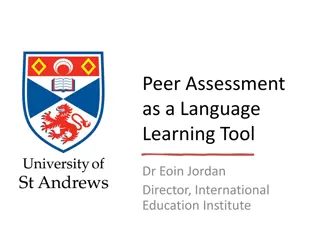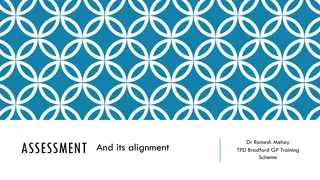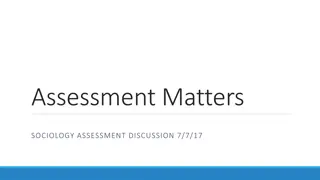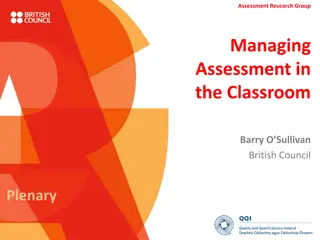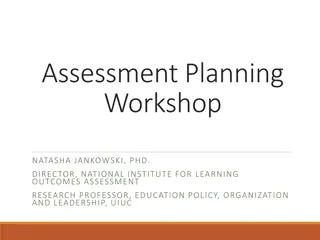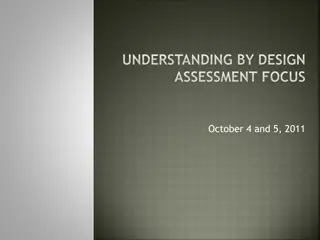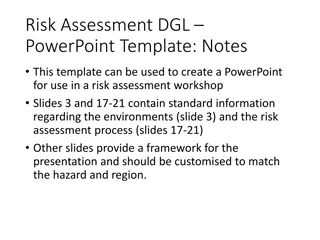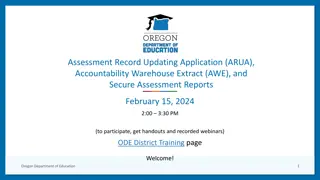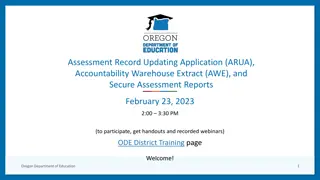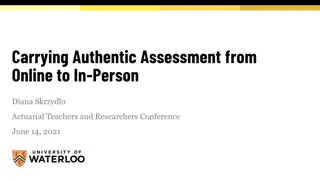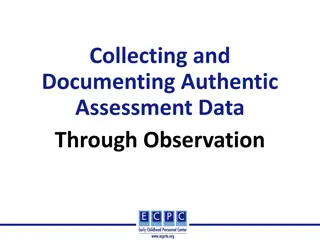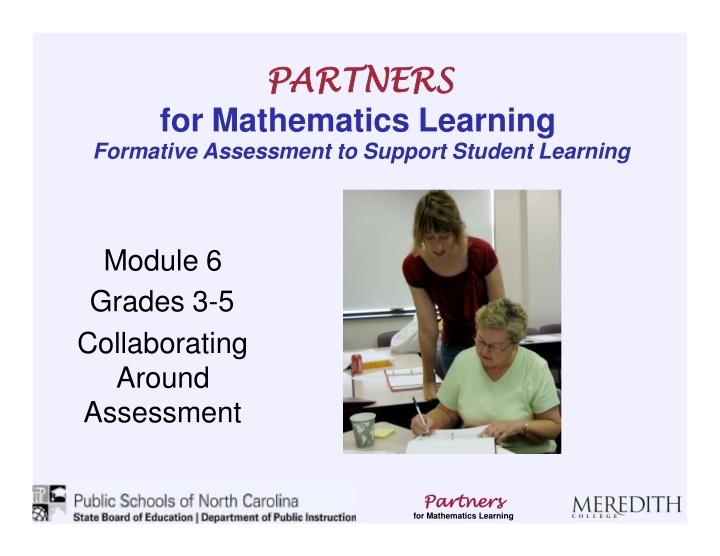
Implementing Formative Assessment Strategies for Mathematics Learning
Explore key strategies and processes for building a comprehensive framework for formative assessment in mathematics education. Discover effective techniques for collaborating around assessment, determining learner progress, and providing valuable feedback. Consider new perspectives on grading and rethink traditional approaches to evaluating student work.
Download Presentation

Please find below an Image/Link to download the presentation.
The content on the website is provided AS IS for your information and personal use only. It may not be sold, licensed, or shared on other websites without obtaining consent from the author. If you encounter any issues during the download, it is possible that the publisher has removed the file from their server.
You are allowed to download the files provided on this website for personal or commercial use, subject to the condition that they are used lawfully. All files are the property of their respective owners.
The content on the website is provided AS IS for your information and personal use only. It may not be sold, licensed, or shared on other websites without obtaining consent from the author.
E N D
Presentation Transcript
PARTNERS PARTNERS forMathematicsLearning FormativeAssessmenttoSupportStudentLearning Module6 Grades3-5 Collaborating Around Assessment Partners Partners forMathematicsLearning
2 OverviewofModules Module1:LearningTargets Module2:QuestioningandTaskSelection Module3:InferencesandFeedback Module4:MakingStudentsActivePartners Module5:DecisionsAboutNextSteps Module6:CollaborationAroundAssessment Partners Partners forMathematicsLearning
3 FormativeAssessment:KeyStrategies Processesforbuildingacomprehensive frameworkforformativeassessment Establishingwherelearnersareintheirlearning Establishingwheretheyaregoing Establishinghowtogetthere Partners Partners forMathematicsLearning
4 FormativeAssessment:KeyStrategies Read Five KeyStrategies forEffective FormativeAssessment atyourtablein jigsawfashion Bereadytosharetheideasinyoursection withyourgroup Whatideasfromthepreviousmodulesare presentedhere? Isthereanythingnew? Partners Partners forMathematicsLearning
5 Grading-ThingsToConsider Noteverypieceofworkneedsagrade Becautiousaboutinferringmasterybased ongrades-even A studentshave misconceptions Sometimeslowgradeshidealotofthinking andknowledge Conversationsandobservationsgiveus agreatdealofinformation BUTgradesarea factoflife Partners Partners forMathematicsLearning
6 Grades WhatDoYouThink? Tyrell sGrades Tests:70,77,93 Classwork:60,65,67,88,90,95 Homework:80,88,90,0,90,95 WhatshouldbeTyrell sreportcardgrade? Decideindividually Comparegradesatyourtable Partners Partners forMathematicsLearning
7 WhatDoesYourGradeMean? GivenTyrell sscoresandyourgrade, whatdoyouknowaboutthemathematics heunderstandsandcanuse? Whatdothegradesortheiraverage tellTyrellandhisparentsaboutthe mathematicsheknowsorabouthis performance? Aregradessummativeorformative? Partners Partners forMathematicsLearning
8 RethinkingGrading Studentwork notagrade-providesa window intostudents thinkingand applicationsofmath Givesteachersinformationforthenextlesson Setsthestageforfeedbacktostudents-either asagrouporindividually Supportsself-assessment:Studentsandpeers cancompareworktorubricsorchecklists Allusesarebeneficial thekeyisbalance Partners Partners forMathematicsLearning
9 Grading-ThingsToConsider Noteverystudentpaperneedsagrade butitdoesneedtobeexamined Considergivingwritten/oralfeedback insteadofagradeonaminimumofone taskorpapereachweek Thereisaplaceforexaminingstudent workandprovidingfeedbackandfor grading thekeyisbalance Partners Partners forMathematicsLearning
10 FormativeInformationforTeachers Thegoalistobecomesocomfortablelooking atstudentworkthatweroutinelyaskourselves thesequestions: Whatismyunderstandingofwhatthestudentdid? Whatmathematicalknowledgedoesthestudent demonstrate? Whatevidencesupportsmyconclusionsabout whatthestudentunderstandsandmydecisions about whatnext ? Partners Partners forMathematicsLearning
11 Teaching-LearningCycle Clear Learning Targets Decisions About NextSteps Questioning& Instructional Tasks Collaboration Around Assessment Making Inferences &Giving Feedback StudentSelf- Assessment& Responsibility Partners Partners forMathematicsLearning
12 EffectiveClassroomEnvironments Asyouwatchthevideo,makenotesabout theaspectsofaneffectiveclassroom environmentthatwehaveexploredinthese modules Whatistheteacher srole? Whatisthestudents role? Howisformativeassessmentdefined? Partners Partners forMathematicsLearning
13 EffectiveClassroomEnvironments Whatarecharacteristicsofthese environmentsthatsupportstudentlearning? Talkatyourtabletoelaborateontheideas Bepreparedtosharewiththegroup Thesecharacteristicsarehardtoprovide consistently Whatsupportsyourimplementationofthem? Howcancollaborationwithcolleagueshelp? Partners Partners forMathematicsLearning
ProcessofFormativeCollaboration 14 WhatAreTeacherCollaborations? Groupsofeducatorsworkingtogetherto improveteachingandlearning Gradelevelteachersplanninginstruction Departmentmeetingsforprogramplanning Teachersinvolvedinlessonstudies ProfessionalLearningCommunities(PLCs) Partnersareusuallyunstructured,butgroups usuallyhaveastructureforcollaboration Partners Partners forMathematicsLearning
ProcessofFormativeCollaboration15 HowShouldTeachersCollaborate? Notforevaluationofoneanother,butfor thesakeofimprovement-thisisthe formativeaspectoftheteachingprofession Inacollegialandsupportiveenvironment- asafeplacetoshare Withaclearpurpose(goal)inmind Whatsuggestionsdoyouhavefromyour ownexperiences? Partners Partners forMathematicsLearning
ProcessofFormativeCollaboration16 UtilizingColleagues Ideas Collaborationscanbeformativewhen teachersstudyteaching: Aplanisdevelopedtowardteachingalearning target Resultsofimplementingthelessonsareshared Studentworkisexaminedandevaluated Discussionoccursaboutwhatmighthappen nextandwaystoimprovethelessons Suchcollaborationshavethepotentialto increasestudentachievement Partners Partners forMathematicsLearning
Modelingtheprocess17 UtilizingColleagues Ideas Aplanhasbeendevelopedtowardteaching dividingregionsintofractionsandidentifying equivalentfractions Dotheactivitytobecomefamiliarwiththetask Whatconceptsmustyouknowtobesuccessful? Isproceduralknowledgeinvolved? Examinestudentworktoseetheresultsof implementingthelesson Evaluatewhathasbeenlearnedandwhatthenext stepsare Howwouldyougroupstudents? Whatactivitywouldyouplanforeachgroup? Partners Partners forMathematicsLearning
18 FractionTask Dividetheshapesonyour handoutintothefractionalparts asdirected Inyournotes,listtheconceptsyoumust knowtobesuccessful Whatproceduresdidyouuse? Whatmistakeswouldyouanticipatethe studentswillmake? Partners Partners forMathematicsLearning
19 Modelingtheprocess WhyThisTask? Whatistheadvantagein usingirregularshapesrather thanallsquaresorrectangles forthisequipartitioningtask? Whatistheunitfractionforeachfigureon thehandout? Whyareunitfractionsimportanttodiscuss withstudents? Partners Partners forMathematicsLearning
Modelingtheprocess 20 MakingPlansfromStudentWork Inyourtablegroupssortstudentpapers accordingtostudentswho Appeartounderstand Showsimilarmisconceptions Showuniquemisconceptionsrelated tofractions Discusswhat nextsteps? youmightplan forthegroups Partners Partners forMathematicsLearning
21 Modelingtheprocess MakingPlansfromStudentWork Twopossible nextsteps Wholeclassdebriefing Planningtieredassignments Whatmisconceptionswouldneedtobe addressedinawholeclassdiscussion? Whatspecificproblems wouldyoupresent? Partners Partners forMathematicsLearning
Modelingtheprocess 22 ProcessofTieredAssignments Identifythelearningtarget Formgroupsbasedonassessments Plananactivityforeachgroupdepending onthestudents needsforthesametarget Needs Attention Developing Mastery Needs Challenge Partners Partners forMathematicsLearning
Modelingtheprocess 23 ExampleofTieredAssignments Learningtarget:equipartitioningaregioninto fractionalparts Needs Attention(Green) Developing Mastery(Yellow) Needs Challenge(Blue) Give each child a sheet of geo-dot paper in 4x6 rectangular shapes. Discuss the number of squares in the rectangle. Have the students Suggest fractional parts Into which the rectangles can be divided. Let them Work in pairs to divide the shapes. Give each child a copy of Shapes similar to the ones in the original student work. Have students Work in pairs to divide the shapes into fractional parts. Have each pair Check with another pair to See if they agree on the divisions. Use the geo-dot paper to Create various shapes that can be divided into thirds, then fourths, then sixths. Show at least four Different ways to divide each shape into that fractional part. Choose other fractional parts and Create shapes for them. Partners Partners forMathematicsLearning
Modelingtheprocess 24 FlexibleGroups:TieredAssignments Directionstostudents: Youwillworkinagroupassignedbytheteacher Ifyouhaveaquestion,andyouarenotworking intheteacher scurrentgroup,youmustaskat leasttwootherpeopleinyourgroupbeforeyou asktheteacher Directionstoteacher: Give gotit and almosthaveit groups independentwork,whileyougetthe notyet groupstarted;keepaneyeontheothers Partners Partners forMathematicsLearning
25 TieredAssignments Tieredactivitiesorlessons Aseriesofrelatedtasksofvaryingcomplexity Relatetoessentialunderstandingsandkey skillsthatstudentsneedtoacquire Assignedasalternativewaysofreachingthe samegoalstakingintoaccountindividual studentneeds Canutilizealternativetasksintextbooks Partners Partners forMathematicsLearning
26 InterventionBeyondDifferentiation Sometimesaddressingmisconceptionsof individualswithinthewholeclassinstruction isnotpossible Interventionsgobeyonddifferentiated assignmentsandarebasedonspecificdata aboutwhatthechildknows/doesnotknow Interventionsarefillingingapsinprior knowledgeandareprovidingbuildingblocks forfurtherinstruction Partners Partners forMathematicsLearning
27 PuttingIdeasintoPractice Findsomeonewhoisnotatyourtableand sharewiththemtheideafromModule5 thatyoutried Didyourideaworkaswellasyouhoped? Whatwouldyoudodifferentlyanothertime? Partners Partners forMathematicsLearning
28 SummativeAssessments Whatisthedifferenceinformativeand summativeassessment? Whatisthepurposeofeach? Someoneoncenotedthatyoucan tmake achickengainweightbyweighingitmore often Howdoesthisstatement relatetotheissueofassessments? ? Partners Partners forMathematicsLearning
29 GoalsofBenchmarkAssessments Whatarethestatedgoalsofbenchmark assessments? Forindividualclassroomteachers? Forallteacherswiththesamegradelevel? Fordistrictleaders? Whatisdifferentaboutthewaysthey shouldbeusediftheyaremeanttobe formativeratherthansummative? Partners Partners forMathematicsLearning
30 UsingBenchmarkAssessments Benchmarkassessmentsarehelpfulif Theirresultscanbeusedtomeaningfully affectinstruction Teacherscanobtainspecificsrelatedtothe mistakesstudentsmade Pacingguidesallowtimeforrevisitingcontent Becarefulthatyou renotjust weighingthechicken! Partners Partners forMathematicsLearning
31 BenchmarkAssessments Multiplechoiceisthemostfinanciallyefficient typeofassessmentforlargescaletesting Theyprovideimportantprogramdatawhenthe samplesizeislarge Well-crafted,theycanhelphighlight misunderstandingsinmathematicalprocesses aswellascontentknowledge Multiplechoicequestionscanbeteaching toolswithintheclassroom Partners Partners forMathematicsLearning
32 MultipleChoiceasaTeachingTool Eachanswerchoice(foil)shouldbebased onareason evenifitslogicisincorrect Plananswerchoicesbasedonanswers studentsarelikelytogive Ifwronganswers(distracters)andthe correctanswerarenumbers,theyshould begiveninascendingordescendingorder Distributecorrectanswers equally among thefourchoices Partners Partners forMathematicsLearning
33 MultipleChoiceasaTeachingTool Whatnumbergoesintheboxinthis equation? 5x3= +4 Thecorrectansweris 11 Whatincorrectanswersdostudents usuallygiveandwhatmisconceptions doeseachrepresent? Partners Partners forMathematicsLearning
34 MultipleChoiceasaTeachingTool Createfouranswerchoicesforthe followingproblem Nancyboughtabirthdaypresentforher brotherfor$2.55andabagofpeanutsfor sixtycents.Shegavetheclerkafive dollarbill.Howmuchchangedidsheget? Partners Partners forMathematicsLearning
35 MultipleChoiceasaTeachingTool Shareyouranswerchoiceswithothersat yourtable Howdotheanswerchoicesyoucreated varyfromothers ? Whatmisunderstandingsmightyouinfer whenastudentchoosesyourincorrect responses? Dosomeanswerchoicesprovidemoreor lessinsightintostudents understandings? Partners Partners forMathematicsLearning
36 MultipleChoiceasaTeachingTool Howcouldyoustructureaclass conversationaroundstudentsdiscussing alloftheanswerchoicestoamultiple choiceitem? Ifanumberofstudentsmissedthesame problemonamultiplechoicetest,how couldworkingingroupstoexplainthelogic behindthewronganswershelpclearup students misconceptions? Partners Partners forMathematicsLearning
37 AlternativeAnswerSheet 201 8is a.)193 b.)203 c.)207 d.)209 Whatcanyoulearnabout student sthinkingwiththisanswersheet? Partners Partners forMathematicsLearning
38 SmallChangesMakeaBigImpact Clarifyinglearningtargetsforyourselfandstudents Designingtasksandquestionstorevealthinking Givingstudentsfeedbacktohelpthemimprove Providingwaysforstudentstoself-assess Givingstudentsrubricsandmodelstodefinewhat goodworkis Usingassessmentdatato improvedecisions Workingcollaboratively Partners Partners forMathematicsLearning
39 Researchsuggests Whenteachersuseformativeassessment, minute-by-minuteandday-by-day to adjustinstructiontofocusonmeeting students learningneeds,therewardsare ample Studentsaremoreengaged Studentsachievehigherstandards Teachersfindworkmoreprofessionallyfulfilling Supportofcolleaguesisessential NCTMAssessmentResearchBrief,2007 Partners Partners forMathematicsLearning
40 ReflectionandDebriefing Acrossthesixmodules,howhaveyour ideasaboutformativeassessment changed? Usethehandoutto examineyouruse ofthestrategies andideasinthese sixmodules Partners Partners forMathematicsLearning
41 ReflectionandDebriefing Setthreepersonalgoalsforyour classroomforhowyourinstructionwill change(orcontinuetochange)inthe nextsixmonths Setatleastonespecificgoalforgreater collaborationwithcolleaguesinthenext sixmonths Howwillyouevaluateyourself? Partners Partners forMathematicsLearning
42 DPIMathematicsStaff ChiefConsultant ReneeCunninghamKittyRutherford RobinBarbourMaryH.Russell CarmellaFairJohannahMaynor AmyScrinzi PartnersforMathematicsLearningisaMathematics-Science PartnershipProjectfundedbytheNCDepartmentofPublic Instruction.Permissionisgrantedfortheuseofthesematerialsin professionaldevelopmentinNorthCarolinaPartnerschooldistricts. Partners Partners forMathematicsLearning
43 PMLDisseminationConsultants JuliaCazin RuafikaCobb AnnaCorbett GailCotton JeanetteCox LisaDavis RyanDougherty TriciaEssick TeryGunter BarbaraHardy KathyHarris RendyKing ReneLemons-Matney TinaMcSwain MarilynMichue KayonnaPitchford RonPowell SusanRiddle AlisanRoyster JudithRucker PennyShockley PatSickles NancyTeague JanWessell DanWicks CarolWilliams StacyWozny Partners Partners forMathematicsLearning
44 2010Writers PartnersStaff JeaneM.Joyner,Co-PI&ProjectDirector FredaBallard,Webmaster AnaFloyd KatieMawhinney AnitaBowman,OutsideEvaluator MeghanGriffith,AdministrativeAssistant KayonnaPitchford WendyRich TimHendrix,Co-PIandHigherEd BenKlein,HigherEducation KatieMawhinney,Co-PIandHigherEd CatherineSchwartz,HigherEducation NancyTeague StacyWozny PleasegiveappropriatecredittothePartnersforMathematicsLearningprojectwhen usingthematerials.Permissionisgrantedfortheiruseinprofessionaldevelopmentin NorthCarolinaPartnerschooldistricts. Partners Partners forMathematicsLearning
PARTNERS PARTNERS forMathematicsLearning FormativeAssessmenttoSupportStudentLearning Module6 Grades3-5 Collaborating Around Assessment Partners Partners forMathematicsLearning


